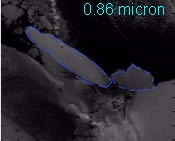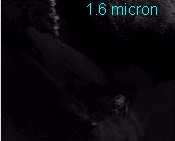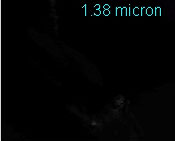Solar wavelengths that differentiate between water and ice 
Images obtained by Low Earth
Orbiting Satellites (LEOS) during daylight hours can come in various
solar wavelengths.
(See Tutorial 1: Remote Sensing). In Step 2 you'll need to select a
solar wavelength that clearly differentiates between water and ice.
|
Images of the
same geographic region at different solar wavelengths (range 0.3 -
3.7 micrometers)
|
 |
 |
 |
| |
|
The highlighted image
above uses a wavelength value that provides good contrast between
ice and surrounding water during daylight. The Energy Reflection
graph below will help you determine the optimal solar wavelength
value.
|
Determining a Solar Wavelength
Use the Energy Reflection Graph to find a
wavelength value with the greatest contrast between ice and ocean
surface properties.
|






